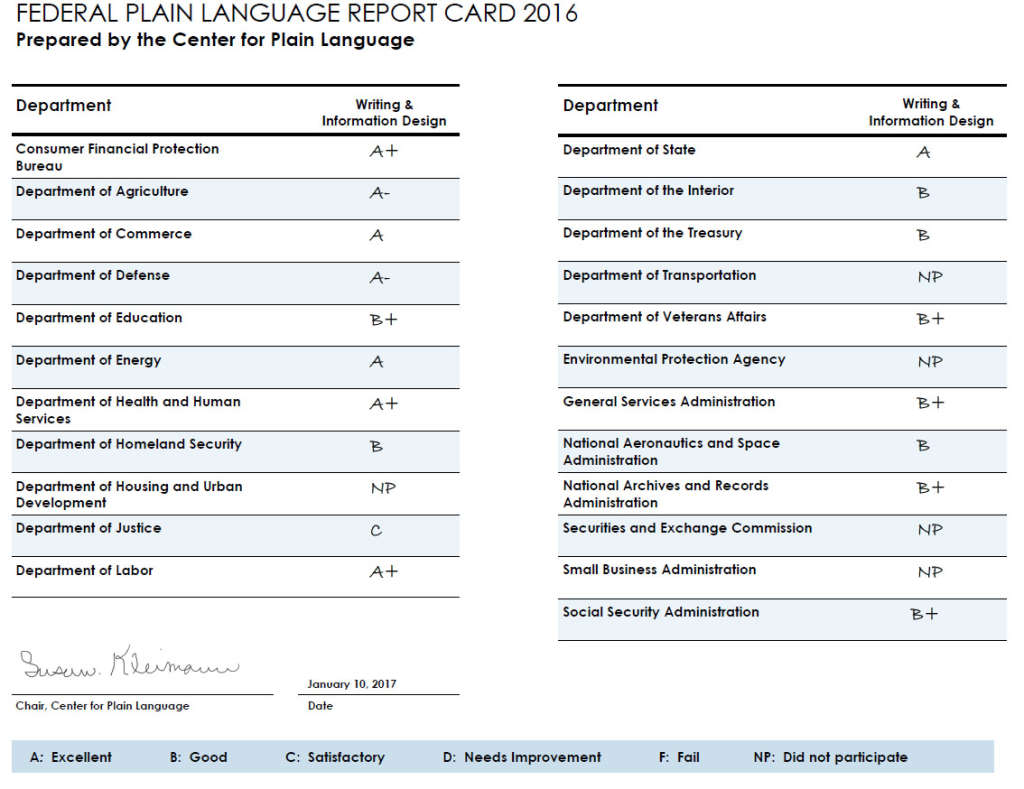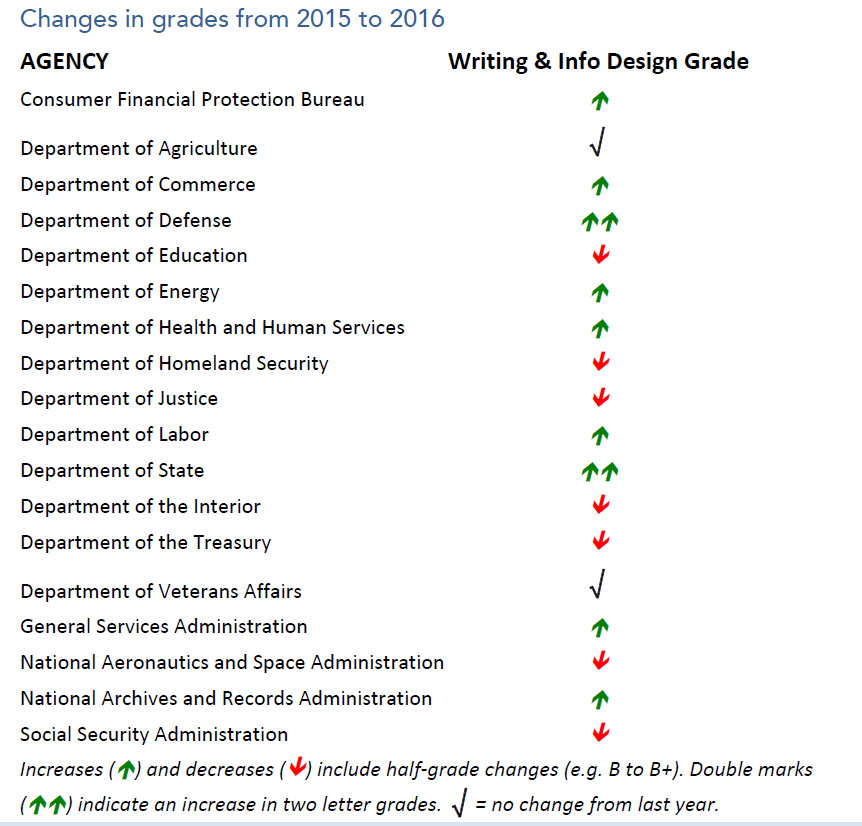
Plain language report card aims to free agencies ‘bogged down by bureaucratic gibberish’
The State and Defense departments showed the most improvement when it comes to providing publication information in understandable language.
Two agencies often criticized for a lack of transparency and complicated businesses earned most improved scores for their efforts to communicate clearly with the public.
According to the Center for Plain Language’s 2016 Plain Language Report Card, the State and Defense departments, the lowest scoring agencies in 2015, showed the most improvement in 2016 with State moving from a “C” to “A” and DoD going up from a “C+” to an “A-.”
The Plain Writing Act of 2010 requires federal organizations to use “plain language” for written and online documents meant for public consumption.
“We … know it’s a slow process and getting more and more people at the various agencies on board,” said Chip Crane, a board member and the Center’s lead for Plain Language Report Card. “People beyond the people who are responsible for the writing, or the plain writing, they don’t do all the writing of course, they just try to promote it. And part of the purpose of this report card is to give them some backing to say, ‘Hey, you know an outside group came and looked at this and yeah, we still have some work to do.'”
The year’s top performers were the Consumer Financial Protection Bureau, the Health and Human Services Department, and the Labor Department.
State and DoD were two of the nine agencies to improve their grades between 2015 and 2016. Seven agencies, however, dropped their scores. The Veterans Affairs, and Agriculture departments, kept their same grades of “B+” and “A-,” respectively.
The Social Security Administration, which has topped the report card with “A+” the past two years, fell to a “B+.”
The Justice Department scored the lowest “C” grade, while the Housing and Urban Development Department, Transportation Department, Small Business Administration, Securities and Exchange Commission, and the Environmental Protection Agency did not participate.
The Center said in its white paper that EPA and SBA told the Center they were declining to participate “based on the nature of their forms and their information collection methods.”
HUD and Transportation did not respond to the Center’s requests.
This is the second year in which no agency scored a “D” or “F.”

“Ensuring clear communication between the American people and the government should be a top priority for our federal agencies,” said Rep. Dave Loebsack (D-Iowa), who joined the Center Jan. 10 for a press call to discuss the report card results. “Federal agencies have a responsibility to provide clear and precise communication, but for years we’ve been bogged down by bureaucratic gibberish.”
A high public burden
This is the fifth year the Center has released a report, and for the first time each participating agency was asked to submit one or two forms and related instructions “carrying a high number of annual public burden hours,” according to the white paper.
“This figure is the product of the estimated average time it takes someone to fill out the form and the number of people submitting the form annually,” the white paper said. “This selection of forms and instructions we graded collectively represent millions of hours of individual users’ time each year.”
The Center worked with CPoint Consulting on the report cards.
“Several agencies’ forms and instructions reflect great care and intentionality toward helping the customers (users) obtain the services they need,” the Center’s white paper stated. “Other submissions, sadly, favor the convenience of the agency and legal language over actually helping the public.”
The volunteer judges scored the agencies based on seven criteria. The criteria were:
- Overall effectiveness.
- Understanding the audience.
- Manner or voice.
- Writing style.
- Structure and navigation.
- Information design and presentation.
- Pictures, graphics and charts (if applicable).
The graders gave scores between 1-5, with 5 being the highest “excellent” score. Each form was graded by two readers and the final score was the average of both.
“To receive an ‘A,’ the average of both graders and (as applicable) both submissions needed to be 4.5 or greater,” the white paper said .”Raw scores ranged from 2.3 (Justice) to 4.95 (Labor). We also added a half-letter grade (e.g., B+ to A-) for agencies that turned in their submissions on time and provided the requested description of audience and purpose along with their documents.”

The Center said some of the best examples of plain language was in the Occupational Safety and Health Administration’s Form 300, which is used to record employee injuries and sickness in the workplace.
Conversely, one of the lower rated documents was the Justice Department’s Drug Enforcement Administration’s form for reporting the manufacturing and distribution of controlled substances.
Graders labeled the form as “confusing,” “impersonal” and “awful.”
Looking ahead
In previous years the report card included agencies’ compliance with the Plain Writing Act, which looked at whether or not an agency had a designated Plain Language Official, and a website dedicated to Plain Language.
The Center decided to change that compliance report from every year to every three years since all agencies were compliant and almost all of them earned “A’s.”
“This change eases the reporting burden on the plain language officials and simplifies the report card assessment process for our volunteers,” the white paper said.
Crane said the Center hasn’t decided what it will look at for next year’s report card, but will likely go back to the Center’s board and volunteers to see what angle would be most helpful for plain language.
“It might be a different genre, maybe go back to some public facing web documents,” Crane said. “I’d like to get input from the … federal folks that deal with these things day in and day out, to find out what would be helpful for them.”
Copyright © 2025 Federal News Network. All rights reserved. This website is not intended for users located within the European Economic Area.



